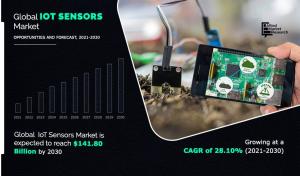IoT Sensors Market Growth Set to Surge Significantly During 2021 – 2030
IoT Sensors Market Expected to Reach $141.80 Billion by 2030
Download Research Report Sample & TOC: https://www.alliedmarketresearch.com/request-sample/A13095
The Internet of Things (IoT) is a complex technology. It has several architecture layers and a network of connected devices that interact with each other to build convenient and valuable applications. Although the components of IoT systems may vary depending on the scope and scale of the application, most of these tools share data collection mechanisms and rely on sensors. IoT sensor is a device that captures real-world data and translates it into a piece of information that could be interpreted by other instruments. There are many different types of sensors used in IoT applications, including acoustic, vibration, load, motion, water & air quality, and even infrared radiation.
The Bluetooth-enabled IoT sensor, which is the most commonly offered wireless type sensor allows data to be transferred to the central terminal for processing regularly. Many of the wireless-type sensors incorporate button or coin cell batteries that allow sensors to acquire data as long as the battery keeps feeding power. Wireless communication function included in these sensors enables to sending of acquired data to other devices.
Prominent factors that drive the growth of the IoT sensors market include the increasing use of sensors in IoT applications, high demand for connected and wearable devices, and growth in the use of IoT sensors in the automotive and industrial sectors. However, data privacy and security-related concerns restrict the IoT sensors market growth. Conversely, surging demand for industrial IoT sensors in the development of smart cities is anticipated to provide potential opportunities for the expansion of the IoT sensors market.
The global IoT sensors market is segmented into type, network technology, end-use, and region. Based on sensor type, it is categorized into temperature sensor, proximity sensor, pressure sensor, level sensor, gas sensor, image sensor, gyroscope sensor, humidity sensor, accelerometer sensor, and others. Based on network technology, it is categorized into wired and wireless. The wireless technology segment is further divided into Wi-Fi, Zigbee, Z-Wave, NFC, RFID, and others. Depending on end use, it is fragmented into automotive, healthcare, food & beverages, aerospace & defense, transportation, oil & gas, agriculture, mining, power & energy, and others.
Get Customized Reports with you’re Requirements: https://www.alliedmarketresearch.com/request-for-customization/A13095
Region-wise, the IoT sensors market trends have been analyzed across North America, Europe, Asia-Pacific, and LAMEA. The analysis had identified that Asia-Pacific contributed for maximum revenue in 2020, and is expected to grow at a faster rate as compared to other regions. Rapid growth of industrialization and the development of smart cities are the key factors responsible for the growth of the market in the Asia-Pacific. In addition, the Asia-Pacific is the largest contributor to the automotive industry due to the growing economy and advancements in the regular framework of sensors.
Competitive Analysis:
The IoT Sensors industry's key market players adopt various strategies such as product launch, product development, collaboration, partnership, and agreements to influence the market. It includes details about the key players in the market's strengths, product portfolio, market size, share analysis, operational results, and market positioning.
Some of the major key players in the global IoT Sensors Market include,
Texas Instruments
TE Connectivity
STMicroelectronics
NXP Semiconductor
Infineon Technologies
Honeywell
Siemens
General Electric
OMRON Corporation
Murata Manufacturing Co.
The impact of COVID-19 on the manufacturing industry has significantly affected the global economy. Electronic components and semiconductor devices are mostly imported from China. Attributed to the temporary shutdown of manufacturing units, prices of semiconductor components have increased, owing to a shortage of supplies. Shortages of components and materials have significantly impacted the global supply chains. In addition, reductions in various capital budgets and delays in various planned projects in various end-use industries have hampered the global economy.
The COVID-19 outbreak has positively as well as negatively affected major businesses worldwide by disrupting production cycles and supply chains across industries. However, as vaccines roll out across the globe and the pandemic situation is better controlled, especially in North America and Europe. This is expected to boost the recovery of the market.
Inquiry before Buying: https://www.alliedmarketresearch.com/purchase-enquiry/A13095
Key Findings of the Study
- In 2020, the pressure sensor segment accounted for the maximum revenue and is projected to grow at a CAGR of 26.50%% during the forecast period.
- The wired segment accounted for more than 60.0% of the IoT sensors market share in 2020.
- The agriculture segment is anticipated to witness the highest growth rate during the forecast period.
- Germany was the major shareholder in the European IoT sensors market, accounting for approximately 36.0% share in 2020.
About Us:
Allied Market Research is a top provider of market intelligence that offers reports from leading technology publishers. Our in-depth market assessments in our research reports consider significant technological advancements in the sector. In addition to other areas of expertise, AMR focuses on analyzing high-tech and advanced production systems. We have a team of experts who compile thorough research reports and actively advise leading businesses to enhance their current procedures. Our experts have a wealth of knowledge on the topics they cover. Also, they use a variety of tools and techniques when gathering and analyzing data, including patented data sources.
David Correa
Allied Market Research
+ + 1 800-792-5285
email us here
Visit us on social media:
LinkedIn
Facebook
YouTube
X
Legal Disclaimer:
EIN Presswire provides this news content "as is" without warranty of any kind. We do not accept any responsibility or liability for the accuracy, content, images, videos, licenses, completeness, legality, or reliability of the information contained in this article. If you have any complaints or copyright issues related to this article, kindly contact the author above.
Reliable Transportation Association Launches Lloyd’s Backed Physical Damage Program for Commercial Auto
Taiwan Postbiotic Food Supplement Market Drivers, Key Players & Opportunities 2024–2027
Interleave Paper Evolves with Food Safety, Automation, and Anti-Static Tech in Global Industrial Packaging Systems
Więcej ważnych informacji
 Jedynka Newserii
Jedynka Newserii

 Jedynka Newserii
Jedynka Newserii

Handel

1 października ruszy w Polsce system kaucyjny. Część sieci handlowych może nie zdążyć z przygotowaniami przed tym terminem
Producenci, sklepy i operatorzy systemu kaucyjnego mają niespełna dwa miesiące na finalizację przygotowań do jego startu. Wówczas na rynku pojawią się napoje w specjalnie oznakowanych opakowaniach, a jednostki handlu powinny być gotowe na ich odbieranie. Część z nich jest już do tego przygotowana, część ostrzega przed ewentualnymi opóźnieniami. Jednym z ważniejszych aspektów przygotowań na te dwa miesiące jest uregulowanie współpracy między operatorami, których będzie siedmiu, co oznacza de facto siedem różnych systemów kaucyjnych.
Ochrona środowiska
KE proponuje nowy cel klimatyczny. Według europosłów wydaje się niemożliwy do realizacji

Komisja Europejska zaproponowała zmianę unijnego prawa o klimacie, wskazując nowy cel klimatyczny na 2040 roku, czyli redukcję emisji gazów cieplarnianych o 90 proc. w porównaniu do 1990 rok. Jesienią odniosą się do tego kraje członkowskie i Parlament Europejski, ale już dziś słychać wiele negatywnych głosów. Zdaniem polskich europarlamentarzystów już dotychczas ustanowione cele nie zostaną osiągnięte, a europejska gospodarka i jej konkurencyjność ucierpi na dążeniu do ich realizacji względem m.in. Stanów Zjednoczonych czy Chin.
Handel
Amerykańskie indeksy mają za sobą kolejny wzrostowy miesiąc. Druga połowa roku na rynkach akcji może być nerwowa

Lipiec zazwyczaj jest pozytywnym miesiącem na rynkach akcji i tegoroczny nie był wyjątkiem. Amerykańskie indeksy zakończyły go na plusie, podobnie jak większość europejskich. Rynki Starego Kontynentu nie przyciągają jednak już kapitału z taką intensywnością jak w pierwszej części roku. Z drugiej strony wyceny za oceanem po kolejnych rekordach są już bardzo wysokie, a wpływ nowego porządku celnego narzuconego przez Donalda Trumpa – na razie trudny do przewidzenia. W najbliższym czasie na rynkach można się spodziewać jeszcze większej zmienności i nerwowości, ale dopóki spółki pokazują dobre wyniki, przesłanek do zmiany trendu na spadkowy nie ma.
Partner serwisu
Szkolenia

Akademia Newserii
Akademia Newserii to projekt, w ramach którego najlepsi polscy dziennikarze biznesowi, giełdowi oraz lifestylowi, a także szkoleniowcy z wieloletnim doświadczeniem dzielą się swoją wiedzą nt. pracy z mediami.



![Nestlé w Polsce podsumowuje wpływ na krajową gospodarkę. Firma wygenerowała 0,6 proc. polskiego PKB [DEPESZA]](https://www.newseria.pl/files/1097841585/fabryka-nesquik_1,w_85,r_png,_small.png)




.gif)

 |
| |
| |
|